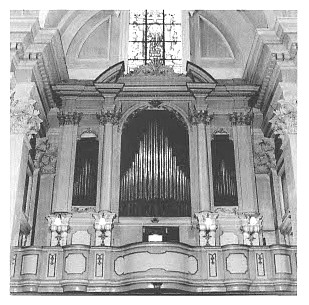|
The present instrument is the work of the famous organ builder of Vicenza, Giovanni Battista De Lorenzi (Schio, 13 March 1806 - Vicenza, 25 December 1883). De Lorenzi used the pre-existing material, though he particularly modified and added to the reed section. The organ stands in a special loft over the main door at the west end of the church. It is enclosed in a monumental 18th-century case, consisting of three compartments separated by two half columns. The Pescantina instrument is one of the few surviving De Lorenzi organs in the province of Verona. The pipes are displayed in three pinnacled compartments: the central compartment has 21 pipes (18th-century pipes, with a high percentage of tin; five of the pipes sound the notes from F-B of the Principale 16', the others belong to the Principale 8'); the side compartments each have 11 pipes (all from the Principale 8'). The pipes have bay-leaf lips and their mouths are horizontally aligned. Immediately behind the displayed pipes are placed the Flaugioletto and the Tromba dolce. There is a single manual of 52 keys (C - g''', with short octave). The natural keys are covered in bone, the sharps in ebony. The straight flat pedalboard is always united to the manual and has 18 pedals (C-a, though pedals g and a command the Terzamano and Timballone respectively); the pedals are completely remade. The stop levers, roughly carved, are arranged in two vertical rows on the right of the console; the printed labels are original.
The divided stops separate between e' and f'. The instrument also has the following accessories:
The first restoration by Alfredo Piccinelli in 1981 The last restoration and cleaning of the instrument was carried out by Giorgio Carli and Romain Legros. Organist Marco Vincenzi. |
